You are using an out of date browser. It may not display this or other websites correctly.
You should upgrade or use an alternative browser.
You should upgrade or use an alternative browser.

Help Support The Homebrew Forum:
This site may earn a commission from merchant affiliate
links, including eBay, Amazon, and others.
Erik The Anglophile
Regular.
Looks nice, I am currently trying to emulate that citrusy hop aroma of Timothy Taylor, and for my currently fermenting one I think I am pretty close. Although straight up cloning brews is something I am not really interested in, I definitely draw inspiration from them...
Thanks for taking the time to post the full recipe and detailsIt was brewday yesterday for the Black Sheep Bitter clone. The Yorkshire yeast never got any bigger than my last photograph above so the Antifoam did the job it was supposed to and I'll certainly use it again in the future.
Here's the recipe I followed (credit: the late Graham Wheeler)
Code:Recipe Specifications -------------------------- Date: 30 April 2022 Batch Size (fermenter): 24.00 L Estimated OG: 1.039 SG Estimated Color: 17.8 EBC Estimated IBU: 30.6 IBUs Brewhouse Efficiency: 78.00 % Est Mash Efficiency: 78.6 % Boil Time: 60 Minutes Water profile: Ca:92 Mg:13 Na:9 SO4:142 Cl:92 Ingredients: ------------ Amt Name Type %/IBU 29.13 L Tesco Ashbeck Water - 3.90 g Gypsum (Calcium Sulfate) (Mash) Water Agent - 3.00 g Calcium Chloride (Mash) Water Agent - 2.70 g Epsom Salt (MgSO4) (Mash) Water Agent - 3.257 kg Crisp Maris Otter (7.9 EBC) Grain 84.6 % 0.380 kg Crisp Torrified Wheat (3.9 EBC) Grain 9.9 % 0.195 kg Crisp Light Crystal (150.0 EBC) Grain 5.1 % 0.020 kg Weyermann Carafa II (1150.0 EBC) Grain 0.5 % 0.80 g Gypsum (Calcium Sulfate) (Sparge) Water Agent - 0.60 g Calcium Chloride (Sparge) Water Agent - 0.60 g Epsom Salt (MgSO4) (Sparge) Water Agent - 15.00 g Challenger [7.70 %] - Boil 60.0 min Hop 13.7 IBUs 10.00 g East Kent Goldings [6.80 %] - Boil 60.0 min Hop 8.1 IBUs 10.00 g Fuggles [5.00 %] - Boil 60.0 min Hop 5.9 IBUs 13.00 g Fuggle [5.00 %] - Boil 10.0 min Hop 2.8 IBUs 1.00 Items Whirlfloc Tablet (Boil 7.0 mins) Fining - 1.0 pkg Brewlab Yorkshire Yeast - Mash Schedule: Single Infusion, Full Body, Batch Sparge Total Grain Weight: 3.852 kg ---------------------------- Name Description Step Temperat Step Time Mash In Add 24.13 L of water at 72C 69.0 C 60 min
Four different grains make up the coloured grain bill. I haven't used torrified wheat for a while now and it makes up 10% of this grain bill.
I've come to expect the Brewlab Yorkshire yeast to attenuate really strongly if I mash at the 'usual' 65-67C range so I'm doing what I did with the Dark Mild and mashing in at 69C in an attempt to reign it in a bit. After an hour the temperature in my thermopot had dropped to 67.6C.
It was a nice and simple brewday and I was all done with the yeast pitched before midday. The OG was 1.040, just one point above the estimate and the colour is a nice light amber.
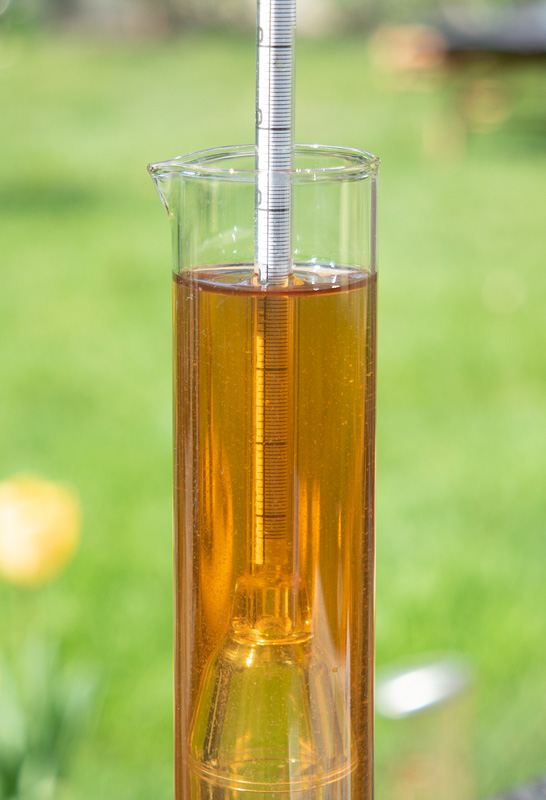
I collected 24 litres into the fermenter, and was able to pitch the Brewlab yeast starter straight away at 20C where it will remain for the next 2 weeks. This time I forgot to decant the starter before pitching so there'll be an extra litre of unhopped 1.036 beer in the mix but previous experience shows that this makes no difference to the end result.
Pitching the yeast at 11am meant that I'd be awake when fermentation started and sure enough by 6pm there was activity through the blow-off tube. As usual I'm running the CO2 produced by the fermentation through the keg that will hold the finished beer to purge it.
I decided not to add antifoam to the fermenter after all though I guess it will get two drops from the starter.
 Much appreciated… I like the sound of this one.
Much appreciated… I like the sound of this one.I still haven't kegged my Black Sheep Bitter clone. The usual 2 weeks fermentation time was up on Sunday but when I went into the garage to check on it the activity in the blowoff tube had increased from a bubble every minute (done) to one every two seconds (wtf). Since my fermenter is a sealed stainless steel item I can't see what's happening but I'd guess that a chunk of krausen had dropped and disturbed 'stuff'. I checked again later at night and the bubbling had dropped back again but it was too late by then so I'll keg it in a few more days. I swear this Brewlab Yorkshire yeast is out to get me.
Happily though, my Theakston's Best clone fermented with 1469 is going down very well indeed. Probably one the best English bitters I've ever done and definitely the best result I've had from 1469. I'll take some pics next weekend.
Happily though, my Theakston's Best clone fermented with 1469 is going down very well indeed. Probably one the best English bitters I've ever done and definitely the best result I've had from 1469. I'll take some pics next weekend.
moto748
Landlord.
- Joined
- Jul 15, 2010
- Messages
- 1,760
- Reaction score
- 1,732
I did a batch of that Threakston's. Although I'm not quite convinced; it's the lowest strength beer I've ever brewed, wondering if it'll be worth the trouble.
14 days since bottling, not touched it yet, but seems to be clearing OK.
I also do my 'Grey Sheep' reguarly, but normally I go with Verdant yeast for that, which I've found works well.
14 days since bottling, not touched it yet, but seems to be clearing OK.
I also do my 'Grey Sheep' reguarly, but normally I go with Verdant yeast for that, which I've found works well.
I finally got around to kegging my Black Sheep Bitter clone after 19 days in the fermenter. I'd normally do it after 14 days but was a little put off by the presence of regular bubbling from the blow-off tube at that stage so I gave it a little while longer.
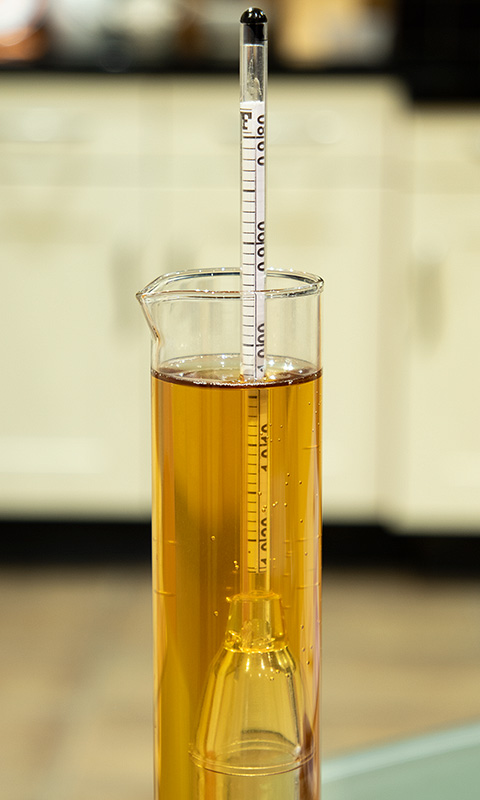
A combination of overshooting my OG by two points and my usual high attenuation (1.004 again) means that I have an ABV of 4.7%, a fair bit more than the target of 3.8%. Never mind, I'll call it Black Sheep Export or something like that.
The yeast had fully flocculated so the bubbling in the blow-off tube might have just been some of the CO2 produced during fermentation off-gassing. I'd noticed that the hydrometer in the picture above had a few CO2 bubbles clinging to it. Perhaps the fact that my fermenter is sealed and the CO2 is routed through a corny (to purge it) before being led to a blow-off tube creates just enough back-pressure to slightly carbonate the beer during the fermentation and that's what comes out afterwards?
Anyway I got a full corny and 4 bottles from the remainder and the sample jar tasted very promising indeed. The corny was fined with gelatine and is on at around 10psi for carbonation and conditioning at 12C.

A combination of overshooting my OG by two points and my usual high attenuation (1.004 again) means that I have an ABV of 4.7%, a fair bit more than the target of 3.8%. Never mind, I'll call it Black Sheep Export or something like that.
The yeast had fully flocculated so the bubbling in the blow-off tube might have just been some of the CO2 produced during fermentation off-gassing. I'd noticed that the hydrometer in the picture above had a few CO2 bubbles clinging to it. Perhaps the fact that my fermenter is sealed and the CO2 is routed through a corny (to purge it) before being led to a blow-off tube creates just enough back-pressure to slightly carbonate the beer during the fermentation and that's what comes out afterwards?
Anyway I got a full corny and 4 bottles from the remainder and the sample jar tasted very promising indeed. The corny was fined with gelatine and is on at around 10psi for carbonation and conditioning at 12C.

£62.70
Cider Making Kit - with Bottles - 10L/2 Gallon/20 Pints Home Brew Beer Ale Lager
247 Homebrew

£13.79
£18.99
New Brewing Lager Beer: The Most Comprehensive Book for Home and Microbrewers
Amazon.co.uk

£23.75 (£25.45 / 75 cl)
Kinsale Mead Co. Atlantic Dry Mead 70cl, Light, Off Dry, Refreshingly Different Award-Winning Honey Mead, 12% ABV
Amazon.co.uk

£73.98
Sanitary clamp 2" (51mm) OD64mm Sanitary Tri-Clamp 90-Degree Pipe With Nipple And Electronic Thermometer, Stainless Steel 304 Home brewing(Without Thermometer)
DAN CHENG XIAN PENG SHI DA SHANG MAO DIAN

£14.76
Digital Temperature Watch Heating Thermometer Home Brewing Tools for Wine Bottle
B&D DIRECT STORE

£5.42 (£0.02 / 100 ml)
Elderflower Sparkling Wine Yeast 5-25L Homebrew Wine, Mead, Cider, Ginger Beer
247 Homebrew

£6.59 (£235.36 / kg)
2X Bulldog Mead Yeast & Nutrient High Alcohol 28g for 20-25L
Virtuoso (VAT Registered)

£437.77
HMCOCOOFM 4L 4" OD119mm * 1.5" OD50.5mm Copper Onion Head For Homebrewing,Thickness 1.5mm (With Thermometer)
weifangguanhuawangluokejiyouxiangongsi
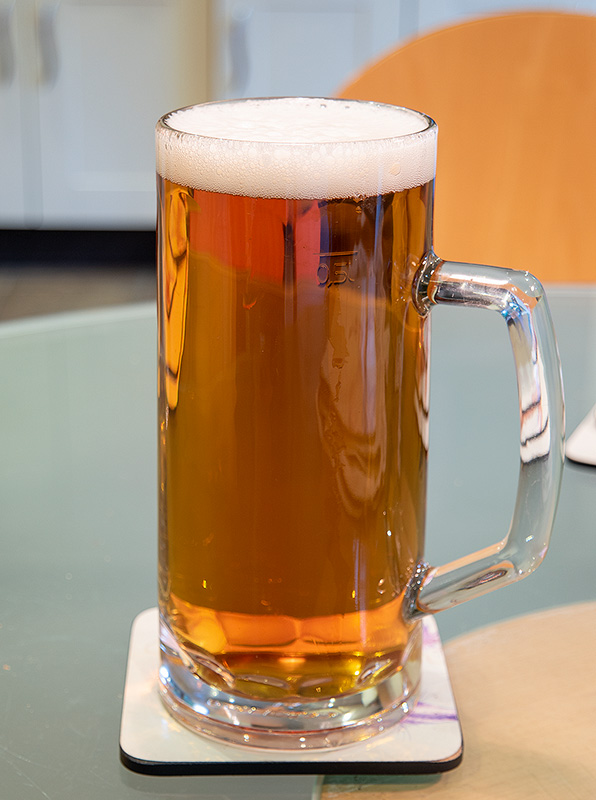
Got to say my Theakstons Best clone is going down really well. Credit to the 1469 yeast for producing the full flavour with a dry finish here. Very easy drinking.
In other news I'll be doing a variation on my Fuggle Duck bitter this weekend. The plan is to sub Fuggle for Saaz and call it Spicy Duck.
This brew is kind of a follow on from my Fuggle Duck recipe that I really enjoyed when I brewed it a few years ago. This time around I'm doing it with First Gold and Saaz which is not a combination I've seen before but I don't see any reason why it shouldn't work. I've gone with "Noble Duck" instead of Spicy Duck which sounded a bit too much like a Chinese take-away.
I'm using my overbuilt starter of Wyeast 1469 that was prepared for my Theakston Best clone. I've done another 1.5 litre starter and saved back 500ml for next time. This brew will get the remaining 1 litre after I've decanted off the spent beer that's sitting atop the new layer of yeast on the bottom of the flask.
Here's the recipe that I came up with.
The original recipe used midnight wheat for colour. This time I'm using the de-husked Carafa Special II and a bit more of it to hopefully give a nice nut-brown colour.
Brew day itself seemed to be going OK. The pre-boil gravity was exactly as expected and the hops started to go in at the intended times. That is, until I reached the final 23g additions and realised I was 16g short of First Gold from my 50g pack.
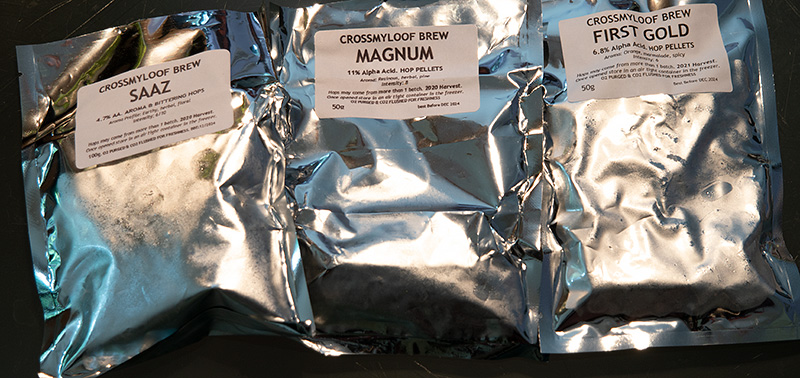
The only possible explanation was that I'd added 32g of First Gold at 10 minutes instead of 16+16 First Gold and Saaz. Oops. To make up for it I made up the missing 16g in the final addition with East Kent Goldings. It'll be alright.
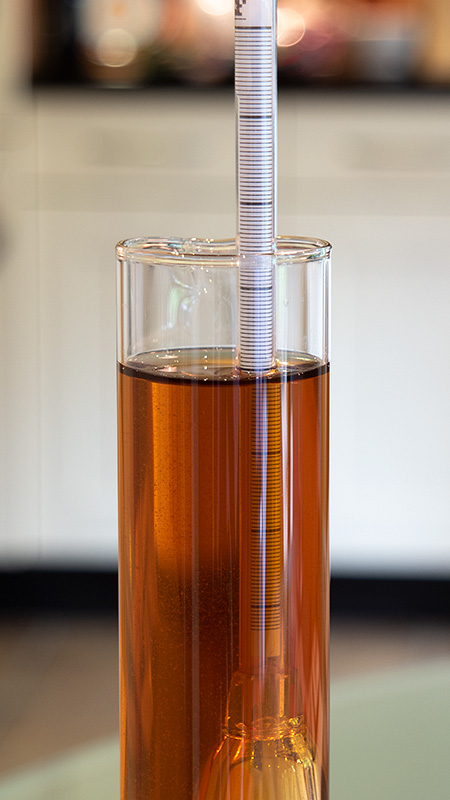
The colour looks nut-brown as I'd hoped and the OG was 1.040, exactly as planned and I got a bit over 24 litres into the fermenter. I managed to get the temperature down to 21C in about 15 minutes with my immersion chiller and then it went into the brew-fridge set to 20C with the keg that I'll be transferring it to hooked up inline with the blow-off tube to purge it with the CO2 produced during fermentation.
I'm using my overbuilt starter of Wyeast 1469 that was prepared for my Theakston Best clone. I've done another 1.5 litre starter and saved back 500ml for next time. This brew will get the remaining 1 litre after I've decanted off the spent beer that's sitting atop the new layer of yeast on the bottom of the flask.
Here's the recipe that I came up with.
Code:
Recipe Specifications
--------------------------
Name: Noble Duck
Date: 4 June 2022
Batch Size (fermenter): 24.00 L
Estimated OG: 1.040 SG
Estimated Color: 29.3 EBC
Estimated IBU: 35.7 IBUs
Brewhouse Efficiency: 75.00 %
Est Mash Efficiency: 75.6 %
Boil Time: 60 Minutes
Water profile: Ca:83 Mg:13 Na:9 SO4:120 Cl:92
Ingredients:
------------
Amt Name Type %/IBU
29.28 L Tesco Ashbeck Water -
3.00 g Calcium Chloride (Mash) Water Agent -
2.90 g Gypsum (Calcium Sulfate) (Mash) Water Agent -
2.70 g Epsom Salt (MgSO4) (Mash) Water Agent -
3.840 kg Crisp Maris Otter (7.9 EBC) Grain 94.0 %
0.163 kg Crisp Medium Crystal (240.0 EBC) Grain 4.0 %
0.082 kg Weyermann Carafa II (1150.0 EBC) Grain 2.0 %
0.60 g Calcium Chloride (Sparge) Water Agent -
0.60 g Epsom Salt (MgSO4) (Sparge) Water Agent -
0.60 g Gypsum (Calcium Sulfate) (Sparge) Water Agent -
11.00 g Magnum [11.00 %] - Boil 60.0 min Hop 14.3 IBUs
11.00 g First Gold [6.80 %] - Boil 15.0 min Hop 4.4 IBUs
11.00 g Saaz [4.70 %] - Boil 15.0 min Hop 3.0 IBUs
16.00 g First Gold [6.80 %] - Boil 10.0 min Hop 4.6 IBUs
16.00 g Saaz [4.70 %] - Boil 10.0 min Hop 3.2 IBUs
1.00 Items Whirlfloc Tablet (Boil 7.0 mins) Fining -
23.00 g First Gold [6.80 %] - Boil 5.0 min Hop 3.7 IBUs
23.00 g Saaz [4.70 %] - Boil 5.0 min Hop 2.5 IBUs
1.0 pkg West Yorkshire Ale (Wyeast Labs #1469) Yeast -
Mash Schedule: Single Infusion, Full Body
Total Grain Weight: 4.086 kg
----------------------------
Name Description Step Temperat Step Time
Mash In Add 24.28 L of water at 70 C 68.0 C 60 min
Sparge: Dunk sparge with 5L
------The original recipe used midnight wheat for colour. This time I'm using the de-husked Carafa Special II and a bit more of it to hopefully give a nice nut-brown colour.
Brew day itself seemed to be going OK. The pre-boil gravity was exactly as expected and the hops started to go in at the intended times. That is, until I reached the final 23g additions and realised I was 16g short of First Gold from my 50g pack.

The only possible explanation was that I'd added 32g of First Gold at 10 minutes instead of 16+16 First Gold and Saaz. Oops. To make up for it I made up the missing 16g in the final addition with East Kent Goldings. It'll be alright.

The colour looks nut-brown as I'd hoped and the OG was 1.040, exactly as planned and I got a bit over 24 litres into the fermenter. I managed to get the temperature down to 21C in about 15 minutes with my immersion chiller and then it went into the brew-fridge set to 20C with the keg that I'll be transferring it to hooked up inline with the blow-off tube to purge it with the CO2 produced during fermentation.
Checked in on the fermentation this morning and... no bubbling. Hmm. The keg being purged had collected enough liquid condensate/suckback starsan from the blowoff jar to block the long liquid dip tube.
There was a strong hiss of CO2 when I pulled the keg PRV and I guess not enough pressure from the fermentation to push the liquid up and out back into the blowoff tube.
I tipped out all the liquid, cleared the tubes and it's all OK now bubbling away madly. Lesson learned and next time I'll swap in a short dip tube on the liquid side while purging.
There was a strong hiss of CO2 when I pulled the keg PRV and I guess not enough pressure from the fermentation to push the liquid up and out back into the blowoff tube.
I tipped out all the liquid, cleared the tubes and it's all OK now bubbling away madly. Lesson learned and next time I'll swap in a short dip tube on the liquid side while purging.
Erik The Anglophile
Regular.
Have you tried doing hopstands?
I did one to try it out in my latest Bitter and will likely in the future just do a 60min bittering charge and then 1-2g/L for a 20min/80c hopstand.
It gave me mostly aroma but plenty of flavour aswell, and more accurate IBU calculations if you replace late boil additions with it.
Maybe up the dose if you want more modern Bitters with a little less dicrete hop flavour/aroma.
I did one to try it out in my latest Bitter and will likely in the future just do a 60min bittering charge and then 1-2g/L for a 20min/80c hopstand.
It gave me mostly aroma but plenty of flavour aswell, and more accurate IBU calculations if you replace late boil additions with it.
Maybe up the dose if you want more modern Bitters with a little less dicrete hop flavour/aroma.
Nope, never done a hopstand to-date. I might give it a go when I next do an American IPA and really want the hops to come through. Thanks!Have you tried doing hopstands?
I did one to try it out in my latest Bitter and will likely in the future just do a 60min bittering charge and then 1-2g/L for a 20min/80c hopstand.
It gave me mostly aroma but plenty of flavour aswell, and more accurate IBU calculations if you replace late boil additions with it.
Maybe up the dose if you want more modern Bitters with a little less dicrete hop flavour/aroma.
moto748
Landlord.
- Joined
- Jul 15, 2010
- Messages
- 1,760
- Reaction score
- 1,732
Your Theaksons looking great there! I made some, but it's paler than yours; I used the lighter of the two lots of crystal I had, and now I wish I'd used the darker. Would have had some effect on the flavour too, no doubt.
It so happens I have some Saaz and First Gold that have sitting in the freezer for a while...
It so happens I have some Saaz and First Gold that have sitting in the freezer for a while...
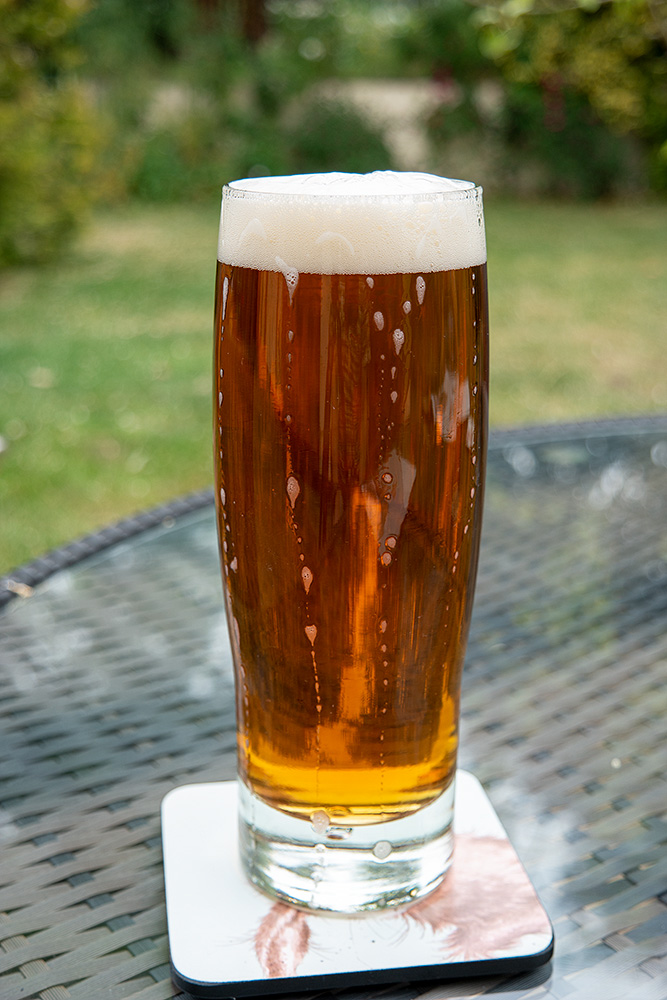
A quick repost of my Black Sheep Bitter clone photo from the big What are you drinking... thread for this brew log thread. This one has come out really smooth and balanced. My best Yorkshire bitter yet using the Brewlab Yorkshire yeast.
I kegged my Noble Duck hoppy bitter yesterday after my standard 14 days in the fermenter.
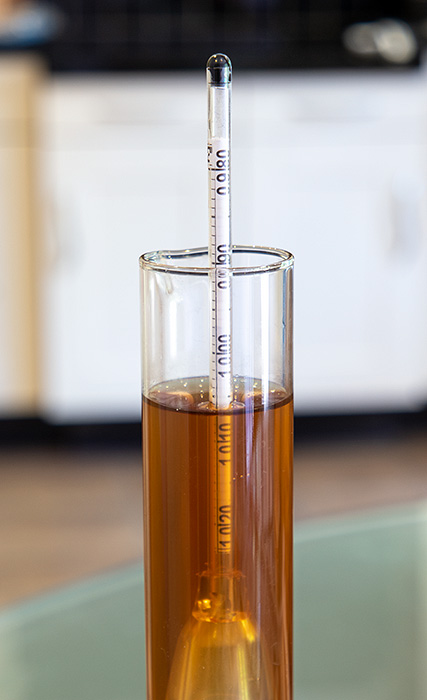
The FG was 1.008 after adjusting the hydrometer reading for its -2 points of inaccuracy. That gives a final ABV of 4.2%. I got a keg and 2 bottles from the fermenter, about a bottle less than usual. I did remember to decant the yeast starter this time which could have been the reason.
Although the photograph doesn't really show it the sample jar was rather turbid in appearance which was slightly concerning given the reliably flocculent performance of Wyeast 1469. I think I may know why. My normal kegging procedure is to first draw off and discard a few hundred millilitres of beer from the fermenter valve to clear out any trub that has settled there and flush out the starsan from the transfer line. Then I fill the keg from the valve. Then I take a sample. Then I fill bottles using however much beer remains until the fermenter valve sucks air. This time the fermenter sucked air after only 750ml of beer so out of curiosity during cleaning I checked how deep 750ml is in my fermenter. It's only 5mm. Therefore I took my sample from the top 5mm of beer where there will have been floating gunge that could have been sucked into the sample jar.
Anyway the keg was fined with leaf gelatine dissolved in water that was boiled and cooled to 65C. I purged the headspace even though the keg was CO2 purged during fermentation. It's now on at my preferred level of 12psi for carbonation and conditioning. Hopefully it'll be all cleared up and tasting good in a month or so. The sample jar tasted fine though obviously 'green', flat and warm. I probably worry too much.

The FG was 1.008 after adjusting the hydrometer reading for its -2 points of inaccuracy. That gives a final ABV of 4.2%. I got a keg and 2 bottles from the fermenter, about a bottle less than usual. I did remember to decant the yeast starter this time which could have been the reason.
Although the photograph doesn't really show it the sample jar was rather turbid in appearance which was slightly concerning given the reliably flocculent performance of Wyeast 1469. I think I may know why. My normal kegging procedure is to first draw off and discard a few hundred millilitres of beer from the fermenter valve to clear out any trub that has settled there and flush out the starsan from the transfer line. Then I fill the keg from the valve. Then I take a sample. Then I fill bottles using however much beer remains until the fermenter valve sucks air. This time the fermenter sucked air after only 750ml of beer so out of curiosity during cleaning I checked how deep 750ml is in my fermenter. It's only 5mm. Therefore I took my sample from the top 5mm of beer where there will have been floating gunge that could have been sucked into the sample jar.
Anyway the keg was fined with leaf gelatine dissolved in water that was boiled and cooled to 65C. I purged the headspace even though the keg was CO2 purged during fermentation. It's now on at my preferred level of 12psi for carbonation and conditioning. Hopefully it'll be all cleared up and tasting good in a month or so. The sample jar tasted fine though obviously 'green', flat and warm. I probably worry too much.
I think that my keg of Black Sheep Bitter will be running out soon so it's time to get another one on the go. This time I'm doing an English IPA featuring Admiral, Progress and Willamette hops with a grist made mainly from Crisp's heritage Chevallier malt.
Tuesday is time to get the starter on the go for a Sunday brew and I'll be using the overbuilt starter from my previous use of the Brewlab Yorkshire yeast that's been in the fridge for two months now.
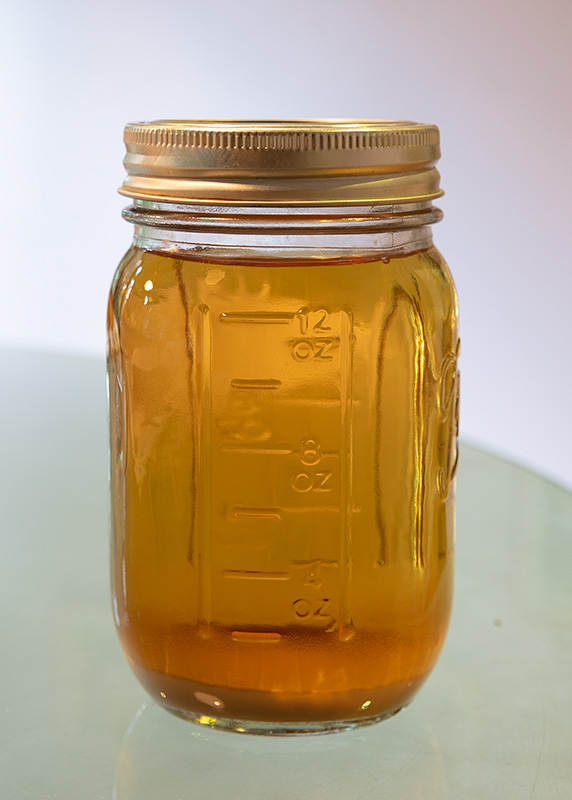
It's looking nice and clear so I prepared a 1500ml starter from 1500ml of Tesco Ashbeck water and 150g of light DME. As usual I boiled it for 10 minutes and then chilled it to around 20C. I remembered to add 2 drops of Brupaks Antifoam to prevent the starter from overflowing.
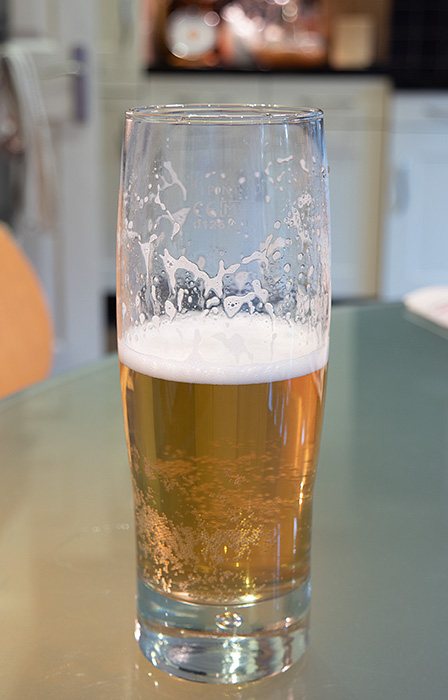
Fancy a half of starter-wort-beer? There was a slight pop when I unscrewed the lid of the jar so I guessed it would be lightly carbonated. It doesn't look too bad really. Head retention: check. Lacing: check. It tasted pretty good too for a two month old glass of fermented DME. A few grams of Goldings and it'd pass muster in many of the dives I've drunk in!
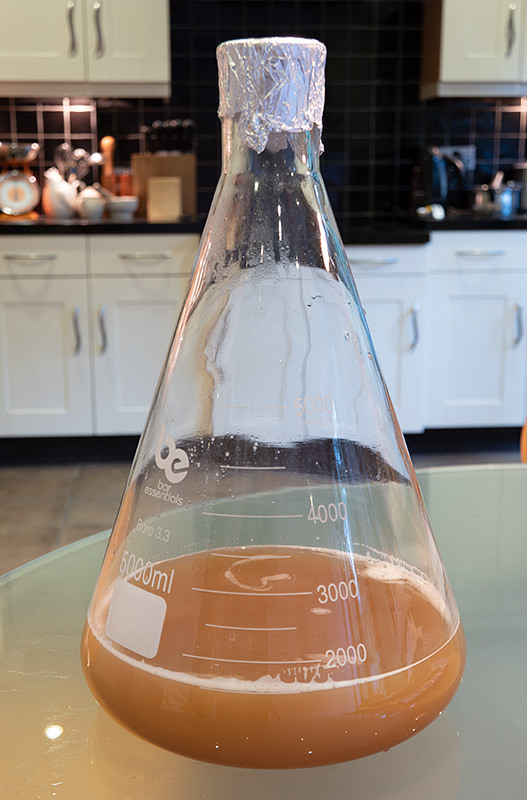
On to the more important stuff, the 1500ml starter is spinning away in the brew fridge at 20C. 500ml will go back in the fridge for next time and a litre will go into the weekend's IPA.
Tuesday is time to get the starter on the go for a Sunday brew and I'll be using the overbuilt starter from my previous use of the Brewlab Yorkshire yeast that's been in the fridge for two months now.

It's looking nice and clear so I prepared a 1500ml starter from 1500ml of Tesco Ashbeck water and 150g of light DME. As usual I boiled it for 10 minutes and then chilled it to around 20C. I remembered to add 2 drops of Brupaks Antifoam to prevent the starter from overflowing.

Fancy a half of starter-wort-beer? There was a slight pop when I unscrewed the lid of the jar so I guessed it would be lightly carbonated. It doesn't look too bad really. Head retention: check. Lacing: check. It tasted pretty good too for a two month old glass of fermented DME. A few grams of Goldings and it'd pass muster in many of the dives I've drunk in!

On to the more important stuff, the 1500ml starter is spinning away in the brew fridge at 20C. 500ml will go back in the fridge for next time and a litre will go into the weekend's IPA.
I've been meaning to ask you, what's the rough timescale you follow and do you do it exactly the same with lager yeast?Tuesday is time to get the starter on the go for a Sunday brew
As you've said there, and I've noted before, you make your starter on a Tuesday ready for a Sunday brew - so you let it ferment out until what, Friday? And then just bung it in the fridge to crash out the yeast for a couple of days so you can decant off the liquor?
Yes that's it. Ferment out until it's visibly done which always seems to be sometime on Friday, decant off what I keep in the fridge for next time then chill the remainder for the weekend's brew. It has to be left until done when overbuilding because it could explode if I put the jar in the fridge while it's still fermenting.I've been meaning to ask you, what's the rough timescale you follow and do you do it exactly the same with lager yeast?
As you've said there, and I've noted before, you make your starter on a Tuesday ready for a Sunday brew - so you let it ferment out until what, Friday? And then just bung it in the fridge to crash out the yeast for a couple of days so you can decant off the liquor?
Sunday was brew-day for my attempt at an English IPA. In an attempt to shorten my brew-day a bit I decided to treat my Tesco Ashbeck water the night before and use a 16A Wifi smart plug to switch it on at 5:25am with the intention of getting up at 6:00am and finding the water at about 55 degrees giving me enough time to grind my grain ready for the mash. The timer worked fine and at 6:00am the water was actually at 63C so next time I'll move the timer forward a bit to give me more time to prepare when I get up.
The actual recipe, Admiral IPA, is an English IPA showcasing Admiral hops with help from Progress and Willamette as the supporting acts and using, for the first time for me, Crisp Chevallier heritage malt. Here's the recipe.
I only had 4kg of the Chevallier malt so I made the rest up with Maris Otter which I've heard can help with conversion in the mash. I mashed for 90 minutes instead of my usual 60 anyway and the pre-boil gravity was exactly as expected with no loss of mash efficiency.
Everything went well with the rest of the brew-day and I collected about 23.5 litres into the fermenter. It seems my boil-off was a bit higher than usual in this hot and dry weather we're having.
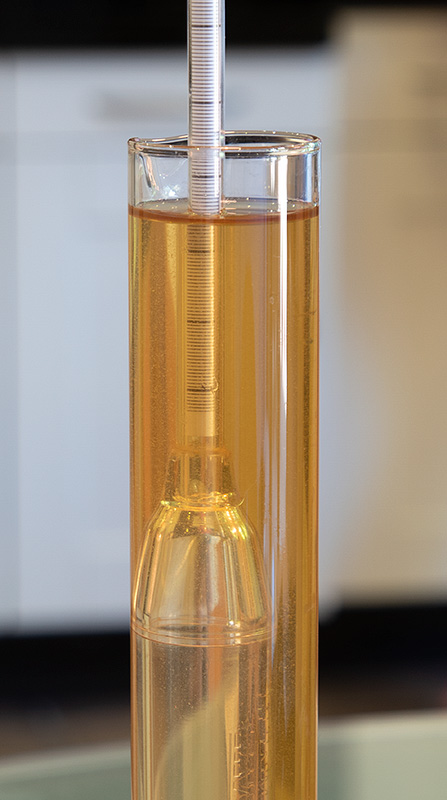
The OG was 1.045, just as planned. I got the wort down to 22C in just over 10 minutes with my Klarstein 12 immersion chiller and pitched the one liter starter of Brewlab Yorkshire right away. It's now tucked up in the brew fridge at 20C fermenting away happily. I don't know if it's the Chevallier malt but the sample jar tasted really, really nice. I'm looking forward to how this one comes out.
The actual recipe, Admiral IPA, is an English IPA showcasing Admiral hops with help from Progress and Willamette as the supporting acts and using, for the first time for me, Crisp Chevallier heritage malt. Here's the recipe.
Code:
Recipe Specifications
--------------------------
Date: 10 July 2022
Batch Size (fermenter): 24.00 L
Estimated OG: 1.045 SG
Estimated Color: 9.5 EBC
Estimated IBU: 42.8 IBUs
Brewhouse Efficiency: 75.00 %
Est Mash Efficiency: 75.6 %
Boil Time: 60 Minutes
Water profile: Ca:90 Mg:12 Na:9 SO4:110 Cl:108
Ingredients:
------------
Amt Name Type %/IBU
3.70 g Calcium Chloride (Mash) Water Agent -
2.70 g Gypsum (Calcium Sulfate) (Mash) Water Agent -
2.50 g Epsom Salt (MgSO4) (Mash) Water Agent -
1.10 ml Lactic Acid (Mash) Water Agent -
4.000 kg Crisp Chevallier Heritage Malt(6.5 EBC) Grain 85.1 %
0.700 kg Crisp Maris Otter (7.9 EBC) Grain 14.9 %
0.80 g Calcium Chloride (Sparge) Water Agent -
0.60 g Gypsum (Calcium Sulfate) (Sparge) Water Agent -
0.50 g Epsom Salt (MgSO4) (Sparge) Water Agent -
15.00 g Admiral [13.00 %] - Boil 60.0 min Hop 22.1 IBUs
15.00 g Admiral [13.00 %] - Boil 10.0 min Hop 8.0 IBUs
15.00 g Progress [8.10 %] - Boil 10.0 min Hop 5.0 IBUs
15.00 g Willamette [5.10 %] - Boil 10.0 min Hop 3.1 IBUs
0.50 Items Whirlfloc Tablet (Boil 7.0 mins) Fining -
20.00 g Admiral [13.00 %] - Boil 2.0 min Hop 2.5 IBUs
20.00 g Willamette [5.10 %] - Boil 2.0 min Hop 1.0 IBUs
15.00 g Progress [8.10 %] - Boil 2.0 min Hop 1.2 IBUs
1.0 pkg Brewlab Yorkshire (1) (Brewlab #Yorkshire) Yeast -
Mash Schedule: Single Infusion, Full Body
Total Grain Weight: 4.700 kg
----------------------------
Name Description Step Temperat Step Time
Mash In Add 24.68 L of water at 70 C 67.0 C 90 min
Sparge: Dunk sparge with 5LI only had 4kg of the Chevallier malt so I made the rest up with Maris Otter which I've heard can help with conversion in the mash. I mashed for 90 minutes instead of my usual 60 anyway and the pre-boil gravity was exactly as expected with no loss of mash efficiency.
Everything went well with the rest of the brew-day and I collected about 23.5 litres into the fermenter. It seems my boil-off was a bit higher than usual in this hot and dry weather we're having.

The OG was 1.045, just as planned. I got the wort down to 22C in just over 10 minutes with my Klarstein 12 immersion chiller and pitched the one liter starter of Brewlab Yorkshire right away. It's now tucked up in the brew fridge at 20C fermenting away happily. I don't know if it's the Chevallier malt but the sample jar tasted really, really nice. I'm looking forward to how this one comes out.
Catching Swans
Active Member
- Joined
- Jun 6, 2022
- Messages
- 54
- Reaction score
- 32
Can I ask, do you have a link to the 16A Wifi smart plug you use and what wattage of heater is it switching?
Mine is a Teckin SP23 16A that I've had for a couple of years now but have only just started using. I think the design is generic and seems to be available under quite a few names on Amazon today but the rating is now 13A. Mine is switching a 10A kettle element.Can I ask, do you have a link to the 16A Wifi smart plug you use and what wattage of heater is it switching?
Similar threads
- Replies
- 4
- Views
- 574
Latest posts
-
-
-
Klarstein Mundschenk stuck mash problems
- Latest: Appleton Brews
-
-
-
-
Wine kit instructiuons don't make sense!
- Latest: Basic Brewing
-
-































